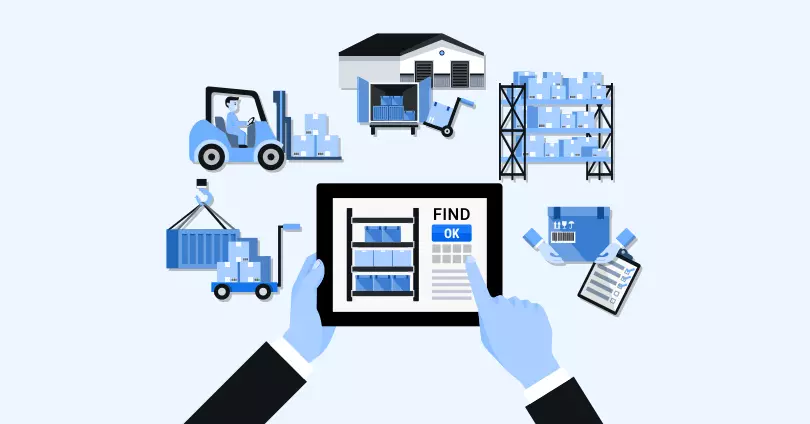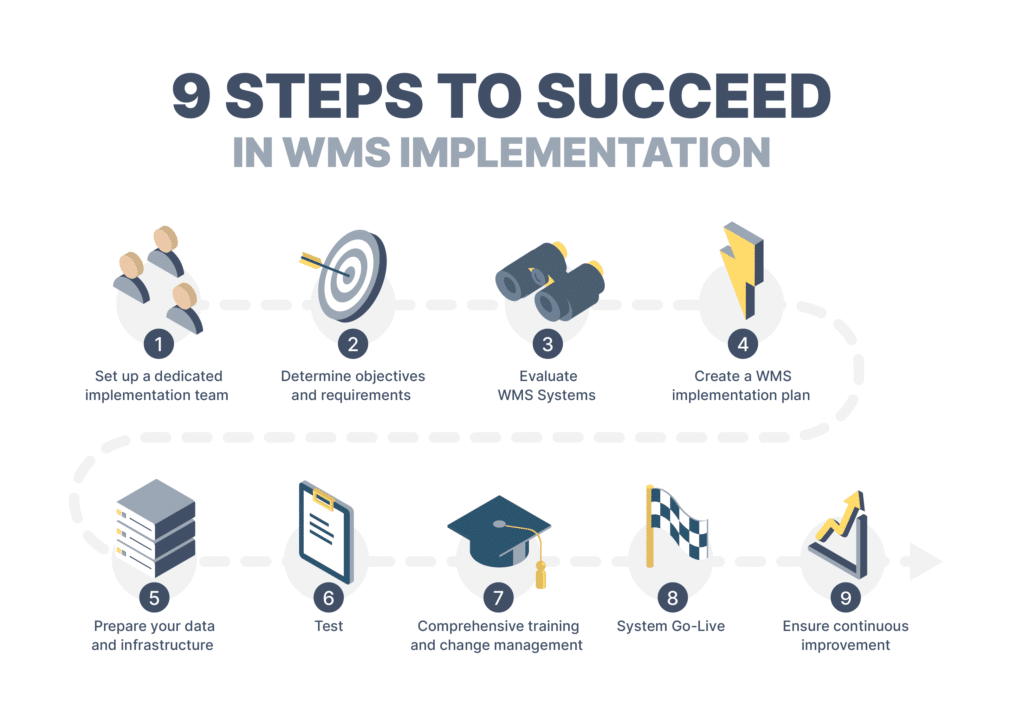Ever wondered how successful businesses keep their inventory straight without a hitch? A Warehouse Management System (WMS) might just be their secret weapon. Whether you’re running a retail store, managing a booming e-commerce site, or leading a large-scale manufacturing operation, the efficiency and precision of a WMS can transform how you handle stock and orders. Companies boost worker productivity, minimize waste, and streamline operations. In a competitive market, these are not merely advantages—they’re essentials. Ready to discover if a WMS fits into your strategy? Let’s see who benefits most.
Understanding Warehouse Management System (WMS)

Warehouse Management System—a term often tossed around in business circles. But what exactly is it? In simple terms, a WMS is a digital solution that helps companies manage warehouse activities effectively. It’s like having an orchestra conductor ensuring all sections play in harmony. Whether you’re running a small business or a large corporation, understanding how a WMS can streamline operations will make your life much smoother.
Key Features of WMS
Trying to comprehend a WMS might feel like navigating a never-ending maze. To make it easier, let’s break it down. A few essential features stand out as major game-changers for improving efficiency and accuracy.
Inventory Tracking
Ever imagine trying to find a needle in a haystack? Without good inventory tracking, that’s basically your warehouse. A WMS provides real-time visibility into stock levels and locations. It acts like your personal GPS, guiding you straight to the item’s shelf or bin.
- Real-Time Data: Updates on inventory are done in real time, offering immediate insights into stock levels.
- Minimized Errors: Manual data entry mistakes are reduced significantly.
- Advanced Scanning: Barcode or RFID scanning ensures fewer mishaps in tracking items.
Order Fulfillment
Think of order fulfillment as a race. Fast delivery and accuracy determine the winners. A WMS is your pit crew, accelerating the speed and precision of processing orders.
- Optimized Picking: The system suggests the most efficient paths to gather items.
- Integration with Sales Platforms: Automatic order updates sync with sales channels, minimizing manual entry.
- Reduce Lead Times: Faster processing equals happier customers and repeat business.
Shipping Management
Handling shipping is like being the mastermind behind a global relay team. Every step counts. With a WMS, managing shipments becomes less about stress and more about checking off boxes.
- Carrier Integration: Connects with your shipping partners for automated label printing and costs.
- Tracking and Tracing: Both you and your customer can follow orders from dispatch to delivery.
- Cost Reduction: Intelligent packaging solutions help avoid overpaying on shipping.
To wrap this up, think of a Warehouse Management System as your friendly operations expert. It improves accuracy and can help make your business more agile. Keep these features in mind, and see how a WMS can revolutionize how work gets done in your warehouse.
Types of Businesses That Benefit from Warehouse Management Systems
Warehouse Management Systems (WMS) are transforming the way businesses handle inventory and orders. By improving accuracy, efficiency, and transparency, these systems cater to a variety of business types, each with its specific needs and demands. Let’s explore how WMS plays a vital role in different industries.
E-commerce Businesses
Running an e-commerce business is like trying to hit a moving target; consumer demand shifts quickly, and inventories must keep up. With the high volumes of orders and returns common in e-commerce, a WMS acts as the perfect sidekick. It manages inventory with precision, tracks parcels in real-time, and helps in hassle-free returns processing. When customers are hunting for speed and accuracy, a reliable WMS keeps things on target by ensuring stocks are updated instantly, orders get packed accurately, and returns are as smooth as silk.
Manufacturing Companies
In the manufacturing realm, managing raw materials and finished goods efficiently can be the difference between staying ahead and falling behind. Enter WMS, like an orchestra conductor for your supply chain. It’s all about harmonizing movements, ensuring raw materials arrive on time, and completed products ship seamlessly. By maintaining inventory at optimal levels, WMS minimizes waste and delays, making sure productivity hits all the right notes.
Retail Stores
Ever walk into a store looking for something, only to find it’s out of stock? This is a retailer’s nightmare. WMS swoops in to save the day by managing inventory levels meticulously. It ensures product availability through accurate tracking and demand forecasting. With a WMS, retail stores experience fewer stock-outs and oversupply issues, leading to happier customers who always find what they come for.
Wholesale Distributors
Wholesale distributors juggle numerous products and orders simultaneously—it’s like spinning plates, and WMS is the anchor they rely on. Ensuring that the right product reaches the right customer becomes a smoother ride with WMS streamlining operations. By improving order accuracy and reducing shipping errors, distributors find they can focus more energy on client relationships rather than firefighting errors or fixing mix-ups.
Third-Party Logistics (3PL) Providers
Third-party logistics providers are the backbone of efficient supply chains. They need eyes all around, metaphorically speaking. A WMS offers comprehensive visibility across the storage, retrieval, and transportation phases. This transparency not only improves operational efficiency but also empowers 3PL providers with data-driven insights, leading to better decision-making and client satisfaction. Enhanced coordination comes easily with a robust system keeping all parties in sync, much like marionettes on strings.
Understanding these diverse applications can help businesses determine how a Warehouse Management System might best serve their unique needs, leading to improved operational outcomes and higher efficiency across the board.
Benefits of Implementing WMS
Adopting a Warehouse Management System (WMS) can transform the way businesses handle inventory, orders, and costs. Imagine being able to track each product, speed up how fast orders go out, and cut down on expenses—all while keeping headaches at bay. Let’s dig into why implementing a WMS is a smart move for any business looking to scale up and smooth out operations.
Improved Inventory Accuracy
Managing inventory can sometimes feel like trying to find a needle in a haystack. Manual processes often lead to human error, missed items, or even overstock. With a Warehouse Management System, you are looking at a major accuracy boost. How does it work? Simple:
- Real-Time Tracking: Know where every item is and where it’s headed.
- Automated Updates: Say goodbye to manual counting. RFID tags and barcodes keep your inventory record spotless.
- Minimized Errors: Errors in data entry become a thing of the past.
Having this kind of accuracy isn’t just about numbers—it’s empowering. It helps you make better decisions and avoids costly blunders.
Enhanced Order Fulfillment Speed
In today’s fast-moving world, nobody likes to wait. Speed is king, especially when it comes to sending out your goods. Using a Warehouse Management System can slash the time it takes to fulfill orders. Here’s how:
- Efficient Picking: Optimize the routes your workers take to gather items. Less time wandering means quicker packing.
- Streamlined Processes: Each step is coordinated seamlessly. From order placement to delivery, everything moves like clockwork.
- Employee Guidance: Clear instructions mean tasks are done right the first time.
This acceleration in order processing isn’t just about being quick. It means happier customers who are more likely to return, boosting your bottom line.
Cost Reduction
Every business loves to save money. Cutting costs is just as important as boosting sales. A Warehouse Management System offers explicit ways to trim expenses without cutting corners. Consider these benefits:
- Reduced Labor Costs: Automation decreases the need for excessive staffing, resulting in lower wage expenses.
- Lower Storage Costs: By better optimizing space and managing stock levels, you spend less on warehousing.
- Less Waste: Avoid overstock and spoilage with precise inventory control.
Think of a WMS like an all-in-one tool, streamlining your business like a streamlined car on the fast lane, nothing holding you back except the potential you’ve yet to tap into.
Making the decision to implement a WMS could be one of the best investments for your company’s growth and efficiency. Why settle for good when you can achieve great with a top-notch Warehouse Management System in place?
Challenges in WMS Implementation
Implementing a Warehouse Management System might seem like a walk in the park, but it’s a journey that requires thoughtful preparation and navigation. Not every business faces the same puzzles, yet some common hurdles need clear-eyed strategies and a practical approach to jump over. Below are two prominent challenges businesses often encounter when rolling out a WMS.
Integration with Existing Systems
Imagine your Warehouse Management System as a new team member eager to make a mark. But if it doesn’t get along with existing crew, trouble looms. Integrating WMS with existing systems like ERP (Enterprise Resource Planning) or CRM (Customer Relationship Management) can be more challenging than one might expect.
- Data Synchronization: Existing data mismatches can cause delays. Think of a puzzle where pieces don’t fit entirely. Without smooth data bridges, it’s hard to transfer correct information.
- Tech Stack Complexity: Already jumbled systems might get muddier. Different software architectures often don’t play well together, and attempting to mesh them might lead you into a labyrinth.
- Vendor Support: Not every technology provider delivers seamless assistance. The quick setup promised might require much more elbow grease than imagined.
For a robust integration, businesses need proactive strategies. Identifying compatibility problems early is critical, just like spotting cracks in a foundation before building.
Training Staff
It’s obvious, yet often overlooked: A system is only as strong as its users. How would you expect to win a game if your team doesn’t understand the rules? Similarly, for a Warehouse Management System to serve its purpose, getting your staff up to speed is non-negotiable.
- Gradual Learning Curve: New tech can be intimidating. Employees might resist, thinking their routines will crumble, especially if training feels like content crammed into infinity.
- Hands-On Practice: It’s essential to offer hands-on opportunities, allowing employees to mix theory with experience, preventing the knowledge from ending up like an unused tool collecting dust.
- Continuous Feedback: Classrooms might offer theory, but real-time support during initial operations keeps the enthusiasm going. Listening to user input can help craft intuitive and user-friendly systems eventually.
Training is the compass that leads your team through new software terrains. Without it, you risk your employees feeling lost, confused, or overwhelmed.
Facing these challenges head-on and preparing adequately will put your business on the right track to reap the benefits of a Warehouse Management System.
Future Trends in Warehouse Management Systems
The Warehouse Management System (WMS) is evolving rapidly, with new trends that promise more efficiency, accuracy, and productivity. Whether you own a big outfit or a small business, knowing these trends can help you prepare for what’s coming next. Imagine a warehouse that’s like a smart house, with everything working together smoothly. From automation to artificial intelligence (AI), here’s how tomorrow’s WMS might change the way businesses handle inventory today.
Artificial Intelligence and Machine Learning
Artificial Intelligence (AI) is revolutionizing lots of industries, and WMS is no exception. Have you ever wondered how a warehouse can predict what will happen next? That’s AI at work. It learns from patterns and data.
- Improved Forecasting: AI can identify trends that humans might miss. It predicts what products will sell and when, so businesses can be ready.
- Smart Decision-Making: Machine Learning algorithms help sort products in a way that reduces walking time for workers, cutting costs and boosting speed.
Automation and Robotics
Automation is like having a team of robots that never take a coffee break. With warehouses getting busier, automation helps manage operations without a sweat.
- Automated Guided Vehicles (AGVs): These are robots that can transport items around the warehouse, leaving humans free to do tasks requiring more thought.
- Drones and Robotics for Inventory Management: Drones hover around and scan inventory, ensuring that what’s on the shelf aligns with what’s in the system.
Cloud-Based Systems
Cloud technology makes a WMS more flexible. Think of it as having your warehouse management office in your pocket.
- Scalability: Whether you’re expanding or cutting down, cloud-based systems adjust effortlessly. As your inventory grows, your WMS keeps up without skipping a beat.
- Accessibility: All the data you need is available from any location, so decision-makers can ensure everything is running smoothly from afar.
Real-Time Data and Analytics
Today’s data is power, and real-time analytics keep businesses ahead of their game.
- Instant Insights: With WMS, you can see inventory levels, order fulfillment status, and shipment tracking all live. It’s like getting an instant report card on how processes are running.
- Enhanced Customer Service: With up-to-date data, businesses can promise more accurate delivery windows and reduce the number of backorders.
Contactless Operations
Especially post-pandemic, minimizing direct contact within warehouses has become a priority. It’s like passing notes in class without needing to hand them over.
- Voice-Activated Commands: From directing robots to finding items on shelves, voice tech is the new radio for warehouses, increasing safety and efficiency.
- Touch-Free Technology: Swiping and tapping have given way to motion sensors and scenic displays that support staff tasks with minimal physical interaction.
Keeping up with these trends not only promises improved efficiency and reduced labor costs, but also prepares warehouses to serve customer demands better than ever. The future of Warehouse Management Systems is already shaping up, with innovation, ease, and speed leading the charge.
Conclusion
A Warehouse Management System is more than just software; it’s an essential asset for a wide range of businesses. From retail giants to healthcare providers, a WMS ensures streamlined operations, reducing errors, and boosting efficiency. These systems are indispensable for companies handling substantial inventory volumes or complex supply chains.
Deciding to incorporate a WMS can position a business for greater success and resilience in today’s competitive market. It’s an upgrade that saves time and cuts costs, making transactions smoother and customers happier.
If you’re operating a business that frequently deals with inventory or logistics, considering a Warehouse Management System could be your next best move. What does efficient warehouse management mean for you? Here’s your opportunity to transform operations and stay ahead.
Let’s discuss how warehouse management systems can unlock new levels of productivity for your business. Scroll down, leave a comment, or reach out to learn more. Your feedback helps drive the conversation forward.








